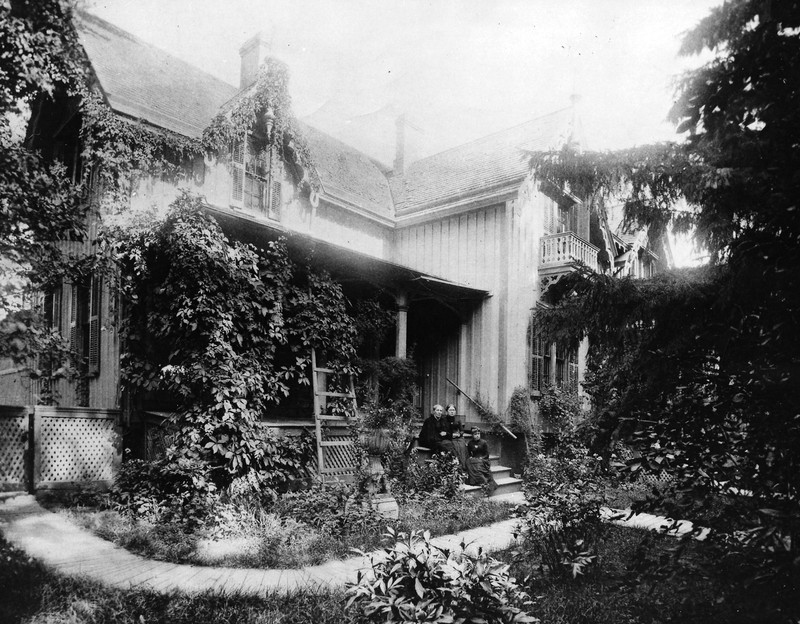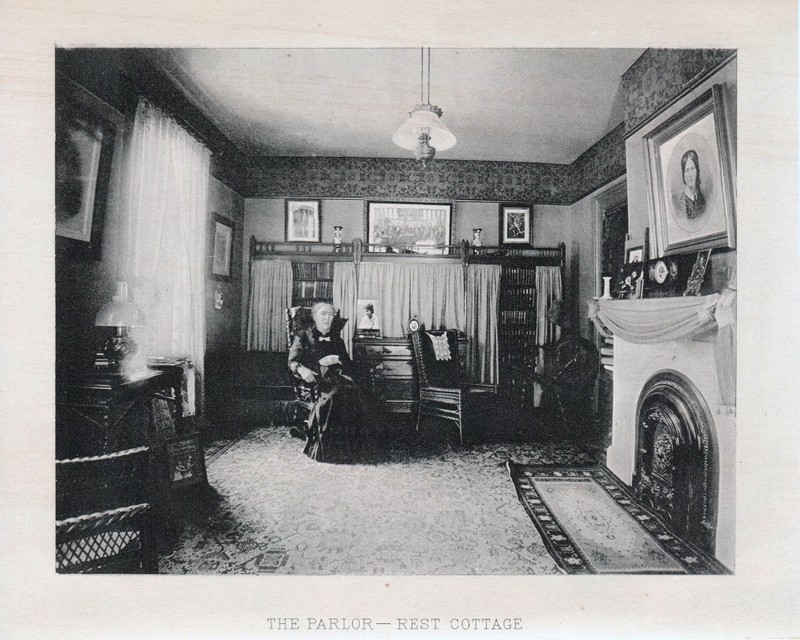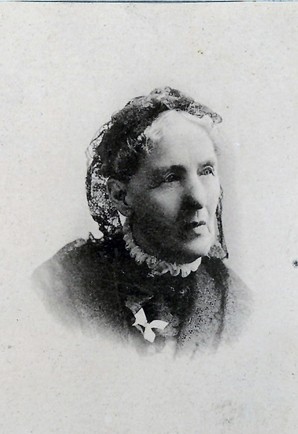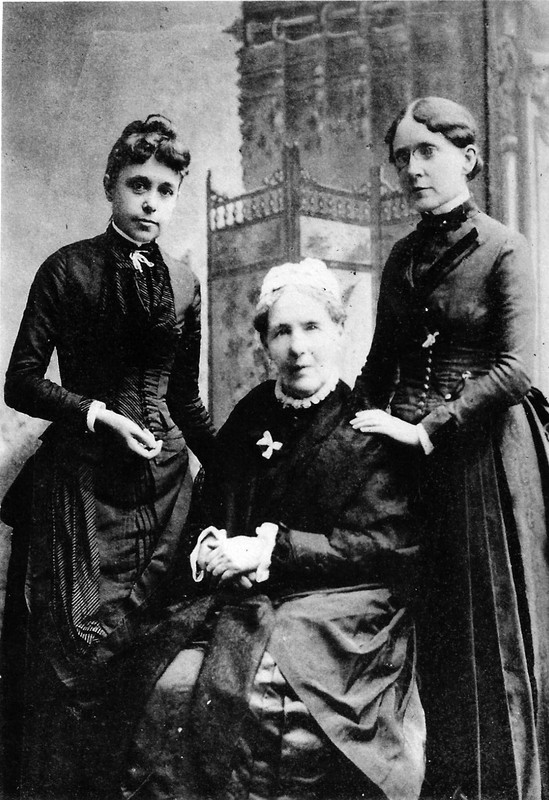Rest Cottage
Introduction
Author-Uploaded Audio
Rest Cottage Introduction
Text-to-speech Audio
Built in 1865, for the Willard family, Rest Cottage served as home for much of Frances Willard’s adult life. It became the base of operations for her trailblazing work on social reform, woman’s suffrage, and the temperance movement. For over two decades, Rest Cottage acted as a home and office for Willard, informal headquarters for the Woman’s Christian Temperance Union (WCTU), and boarding house for WCTU workers. In 1900, shortly after France Willard’s passing, the WCTU established Rest Cottage as the Frances Willard House Museum. Today, the museum is open to the public and serves as a memorial, museum, and archives for Willard’s profound legacy. Visit franceswillardhouse.org for tour availability and reservations.
Images
Frances Willard sitting with her mother, Mary Hill Willard, and Ann Gordon on the front steps of Rest Cottage, Evanston, IL, 1884.

Studio mother-daughter portrait of Frances Willard standing behind her mother.

An interior view of the parlor (the front room on the rigtht as viewed from the street) shows Frances' favorite room in the house, Evanston, IL.

Studio portrait of Frances Willard's mother, Madam Mary Hill Willard, who was referred to by WTCU worker as "St. Courageous" for her incredible spirit.

Studio portait of Anna Gordon (left), Madam Willard (center), and Frances Willard (right), Evanston, IL, 1885.

Backstory and Context
Text-to-speech Audio
Although no longer a household name, Frances Willard was considered one of the most significant and inspirational social activist leaders of the 19th century. After resigning as president of the Evanston Ladies College in 1873, Willard felt a calling to join the Temperance Crusades sweeping across the nation. By 1874, she was the first president of the newly founded Woman’s Christian Temperance Union (WCTU) of Chicago. Shortly after, she was appointed corresponding secretary of the national organization. Willard would go on to become president at both the Illinois state and national WCTU. She also played a pivotal role in the formation of the World’s WCTU. Her contributions included advocacy for women’s rights and labor rights, and she provided keen leadership for women’s suffrage and temperance movements. Through her profound national and international influence, Frances Willard made a name for herself and Evanston, Illinois.
For a 19th-century woman, Frances Willard was highly educated and extraordinarily progressive in her views and advocacy. This was not due to happenstance. She had the immeasurable support and love of her mother, Mary Hill Willard, who deserves much credit for Frances Willard’s success in life. Mother Willard had a profound impact on the course of Frances Willard’s life and legacy. According to Willard, “Mother never said, ‘You must cook, you must sweep, you must sew,’ but she studied what we liked to do and kept us at it with no trying at all” [1]. This allowed Willard the freedom to explore opportunities beyond the domestic sphere deemed appropriate for young ladies of her time.
Rest Cottage and Mother Willard became the touchstone of Willard’s life and accomplishments. In 1865, Willard’s father, Josiah Willard, commissioned the building of Rest Cottage. Sadly, Mr. Willard passed away just three years after its completion when Willard was twenty-nine. After various teaching positions and a couple of years of international travel, Willard and her mother settled into Rest Cottage, where they lived together for the next two decades.
“Rest Cottage revolved around Mother Willard as its central luminary” [2]. It was not long into Frances Willard’s tenure with the WCTU that Rest Cottage became a hub of activity supporting her professional endeavors. Over the years, and through a series of additions, the house served as a residence for immediate and extended Willard family members and close friends, unofficial and then official headquarters for the WCTU, and lodging for WCTU workers. But, at the heart of it all, Mother Willard was the steady and supporting force at Rest Cottage who made it possible for Frances Willard to travel the world in pursuit of her calling.
Mother Willard – known fondly as “Saint Courageous” – was loved and revered by all WCTU workers at Rest Cottage. On the second floor, her bedroom, where she scrapbooked, read, and wrote letters, was known as the “chamber of peace” [3]. Mother Willard not only ensured the home front at Rest Cottage ran efficiently, but she also was an active supporter and participant in WCTU activities and events. She served as president of the local WCTU and often accompanied Frances Willard’s delegation to state and national WCTU conventions, where she enchanted and entertained audiences. At a memorial service following Madam Willard’s death, Lady Isabel Somerset, Frances Willard’s close friend and fellow WCTU leader, remarked, “when the lives of mothers of great woman are written, and Frances Willard’s name stands upon those pages, it will be the mother who made her all she is for the cause of woman and humanity…” [4].
“Frances Willard never severed her affectional ties with her mother, and she surrounded herself with affectionate admiring women for the rest of her life” [5]. But in 1892, at the age of eighty-seven, Mother Willard passed away. For Willard, the loss was beyond devastating. Considering her failing health, Willard left Rest Cottage in 1896, for England and passed away just six years after her mother in 1898. Rest Cottage was bequeathed to Willard’s dearest friend and WCTU colleague, Anna Gordon. She ensured that Willard’s legacy, the WCTU, and Rest Cottage would be remembered by future generations.
Sources
[1] Frances Willard, Glimpses of 50 Years, 1839-1889 (Chicago: Woman’s Temperance Publication Association, 1889), 25.
[2] Frances Willard and Minerva Brace Norton, A Great Mother: Sketches of Madam Willard (Evanston, IL: Woman’s Temperance Publishing Association, 1894), 232.
[3] Willard and Norton, A Great Mother, 229.
[4] Willard and Norton, A Great Mother, 289.
[5] Ruth B. Bordin, Frances Willard: A Biography (Chapel Hill: University of North Carolina Press, 1986), 18.
8"x10" photograph, Frances Willard Archives, Binder: Photos, Rest Cottage, Exterior.
3"x5" photograph, Frances Willard Archives, Binder: Willard Family and Homes
8"x10" photograph, Frances Willard Archives, Binder: Photos, Rest Cottage, Interior.
3"x5" photograph, Frances Willard Archives, Binder: Willard Family and Homes
3"x5" photograph, Frances Willard Archives, Binder: Willard Family and Homes
